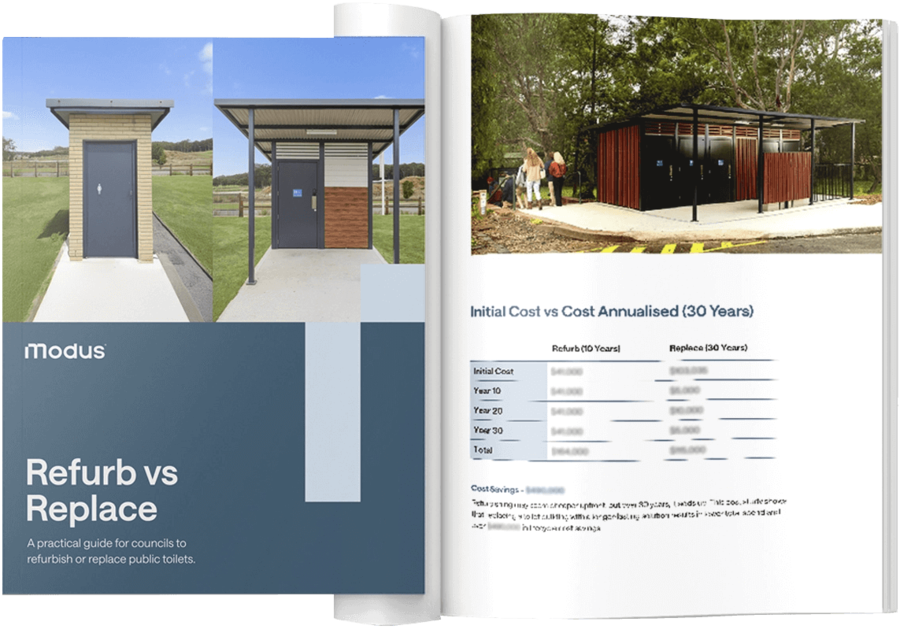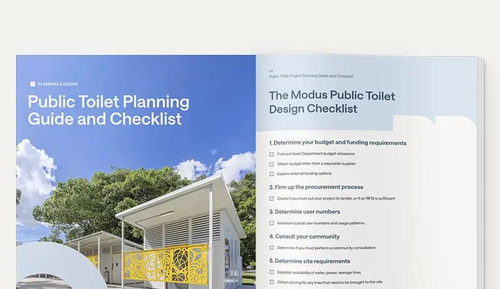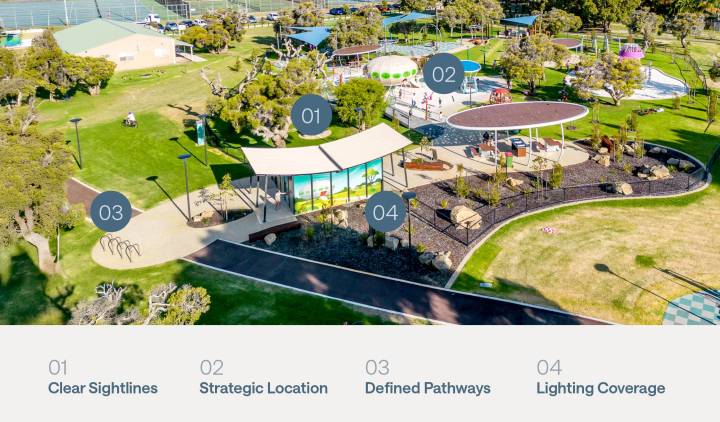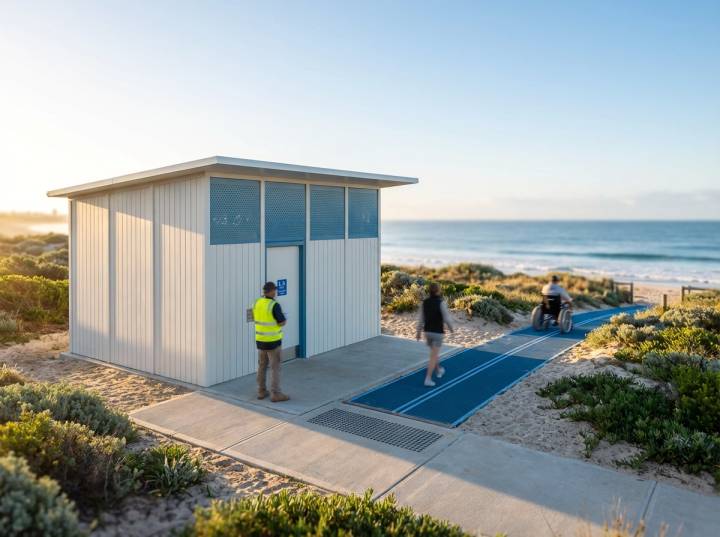Refurb vs Replace: Is a patch-up costing you more?

Local government public toilet facilities at places like parks, sporting facilities and other venues are vital pieces of community infrastructure that contribute to resident and ratepayer satisfaction, public health, and general area amenity.
But, with time and use, any public facility will, eventually, become run-down and start to look tired and old. It may have attracted significant, difficult-to-repair vandalism. It may no longer have the level of amenity that people expect as times and standards change, and technology evolves.
When this happens, modern council asset and facility managers are increasingly finding themselves faced with budget constraints and competing priorities.
Refurbishment of existing toilet blocks often feels like the only viable option. The reality is that in local government there is significant financial pressure to "make do" with aging public facilities and just go with a “touch up”.
But do these short-term fixes pay off when compared to strategic long-term planning? Let’s explore.
At a glance: refurbish or replace?
Refurbishment often seems like the budget friendly choice, but it carries significant risk. A patch up job can lift appearances for a while, yet it rarely resolves structural or compliance issues. Replacement offers a fixed price outcome with a 30 - 40 year structural design life. For most ageing toilet blocks, replacement delivers better value, certainty and community outcomes over the life of the asset.
| Aspect | Refurbishment | Replacement |
|---|---|---|
| Structural certainty | Unknown until works begin | Engineered new structure |
| Cost blowouts | Common, unexpected damage and variations | Fixed price contract available |
| Lifespan | Typically adds around 5 - 10 years | Designed for a 30 - 40 year asset life |
| Compliance risk | Often does not meet AS1428 and NCC | Can be fully compliant with current standards |
| User experience | Old, dated, often odorous | Modern, clean, safe facilities |
| Structural warranty | No structural warranty | Long term structural warranty available |
| Design aesthetic | Limited by existing shell | Designed specifically for your site |
Why refurbishment often fails for ageing public toilet blocks
Refurbishment involves retaining the basic structure while upgrading components, fixtures, and finishes. While this approach appears cost-effective initially, "kicking the can down the road" can result in mounting (costly) problems.
Common issues in old facilities include trying to remediate rust and vandalism damage. But limited accessibility that causes regulatory non-compliance is also a common feature of old toilet facilities and refurb-ing to fix these sorts of problems can prove difficult and expensive.
In fact, compliance with current standards, particularly with AS1428 accessibility requirements and National Construction Code provisions, often cannot be fully achieved within the constraints of existing structures. Thus, even with the best intentions, a refurbished facility may still deliver a compromised user experience simply due to the limitations of a dated layout, or inherent safety limitations in the original design.
The structural integrity of the facility also often remains unknown until works actually begin, leading to cost blowouts when unexpected damage is discovered.
As a result, facility and asset managers face significant uncertainty, and the real refurbishment cost often isn't entirely what managers see in the quote or tender.
Even after completion, refurbished facilities typically deliver a limited lifespan of about eight to ten years before requiring additional investment. Plus, warranties are typically limited or non-existent.

Refurbishments typically provide about eight-ten years of value before they are overtaken by continued wear and (rapidly) escalating maintenance costs.
What does replacement give us that refurbishment cannot?
Comparatively, a knockdown-rebuild approach can provide both structural and financial certainty.
On the financial side, contracts typically operate on fixed prices with minimal variations, eliminating the bill shocks that can come with a refurbishment. Additionally, new facilities generally include substantial warranties — often up to 20 years on structural elements, providing budget certainty for long-term asset management.
A completely new construction also eliminates regulatory risks associated with partially compliant refurbished facilities: new constructions are designed for full compliance with current accessibility requirements and construction standards. User experience is dramatically improved through modern, clean, and safe designs that reflect contemporary expectations about public sanitation facilities.
A brand-new multipurpose toilet facility will also last longer maybe 30 to 40 years. This delivers greater long-term value despite the higher initial investment.
In fact, when you compare a useful life of 40 years for a new build with as little as five years for a refurbishment, it becomes clear how much cheaper refurbishment would need to be to truly stack up. In practice, it is unrealistic to expect refurbishment to be several times cheaper than a new build once you factor in its shorter lifespan and higher risk of cost blowouts.
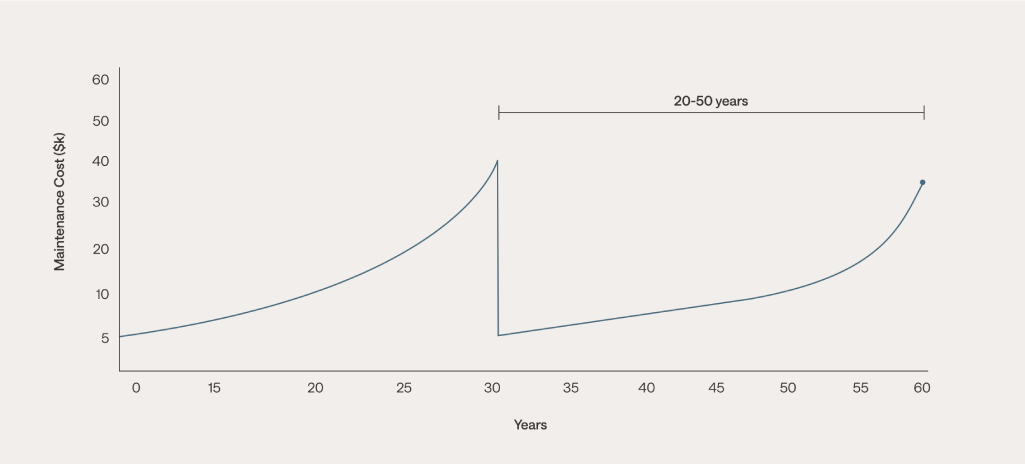
Building an entirely new facility from the ground-up conveys long-term operational cost benefits.
When refurbishment can still make sense
Refurbishment is not always the wrong decision. It can be a sensible option when the existing building is structurally sound, broadly compliant with current standards and holds genuine heritage or civic value that would be difficult to recreate. It can also be appropriate for minor cosmetic works where the goal is a short term refresh rather than a full life cycle extension.
- Heritage value: The structure has recognised historical or civic significance that the community wants to retain
- Structural health: Concrete, steel and footings are confirmed to be in excellent condition through investigation
- Minor scope: Only cosmetic changes such as paint, fixtures or lighting are required, with no major structural alterations
Community and Civic Value
Beyond the practical considerations, the decision between refurbishment and replacement carries significant implications for community perception. A new facility signals investment, care, and modern standards to residents and visitors alike. Safer, cleaner, and more accessible facilities generate greater community satisfaction while helping councils avoid public backlash from deteriorating infrastructure.
Public toilet facilities might seem utilitarian, but they represent a visible touchpoint between councils and communities. A toilet building isn't just a utility, it's a reflection of how you treat your community.
Rebuilding demonstrates commitment to quality infrastructure and can strengthen council reputation through visible infrastructure wins that community members interact with regularly.

Minister for Social Services Amanda Rishworth, Erin Thompson MP, Mayor of Marion Chris Hanna, Disability Advocate Shane Hryhorec, and the team at Department for Environment and Water at our Changing Places Facility in Glenthorne National Park.
Making Strategic Decisions
When considering these options, asset managers should conduct a comprehensive lifecycle cost analysis. While rebuilds require higher initial investment, the extended asset life and reduced maintenance costs often provide superior value over a 20 to 50 year horizon. The predictability of new construction also simplifies asset management planning and budgeting processes.
Usage patterns and future demands should factor into decision making. Growing areas or changing demographics may require completely different designs than existing facilities can accommodate. Modern rebuilds can incorporate sustainable design principles that reduce operational costs and environmental impact over the facility’s lifespan.
Refurb or replace? A quick decision checklist
Asset managers can use these questions to stress test their decision and check whether refurbishment really stacks up against replacement.
Summing Up
While refurbishment may appear the pragmatic choice when facing immediate budget constraints, replacement often delivers superior long-term outcomes across multiple dimensions. By thoroughly evaluating both options against a comprehensive framework that includes structural certainty, compliance requirements, lifetime costs, and community impact, councils can make decisions that truly serve their communities.
The most successful asset managers look beyond immediate budget cycles to consider whole-of-life costs and strategic asset management principles. When a facility has reached a critical point of deterioration, investing in complete replacement rather than perpetual refurbishment can represent both financial wisdom and community leadership.
Rebuilding demonstrates commitment to quality infrastructure and can strengthen council reputation through visible infrastructure wins that community members interact with regularly.
Frequently Asked Questions
What are the biggest risks with refurbishing old toilet blocks?
The primary risk is the unknown. Once works begin, hidden issues such as concrete cancer, rusted reinforcement or non compliant plumbing often emerge, leading to significant variations and cost blowouts.
- Latent conditions: Hidden structural damage that drives up costs
- Compliance gaps: Inability to meet modern accessibility and safety standards
- Short lifespan: Investing capital for only a brief extension of service life
How do we build a business case for replacement, especially when budgets are tight?
Focus on whole of life costs rather than just the upfront capital. A replacement can lower ongoing maintenance, reduce vandalism risk through better design and remove the need for another major intervention in 5 - 10 years.
- Lower maintenance: New materials and fixtures require less ongoing repair
- Risk mitigation: Reduces safety and compliance liabilities associated with ageing assets
- Long term value: Spreads the investment over a 30 - 40 year life rather than a 5 - 10 year extension
How do we prioritise which facilities to replace first?
Most councils cannot replace every ageing toilet block at once. Looking at risk, usage and visibility side by side makes it easier to decide which sites should move to the top of the list.
- Usage and location: High use sites in prominent parks, town centres or tourist locations
- Compliance and safety risk: Facilities with major accessibility gaps, CPTED concerns or repeated incidents
- Maintenance history: Buildings with frequent breakdowns, leaks or vandalism repairs
- Community feedback: Locations that attract regular complaints from residents or visitors
- Future plans and funding: Sites that align with upcoming masterplans, upgrades or grant opportunities
Can refurbished toilet blocks ever be fully AS1428 compliant?
In many older toilet blocks it is very difficult to achieve full AS1428 accessibility within the existing shell. Doorways, circulation spaces and ramps were not designed to current standards, and changing them often means moving or rebuilding structural walls.
- Physical limits: Existing footprints can make compliant circulation and door widths hard to achieve
- Structural cost: Moving load bearing walls and slabs can cost almost as much as a new build
- Residual risk: Even after spending on upgrades, councils may still carry accessibility and compliance risk
